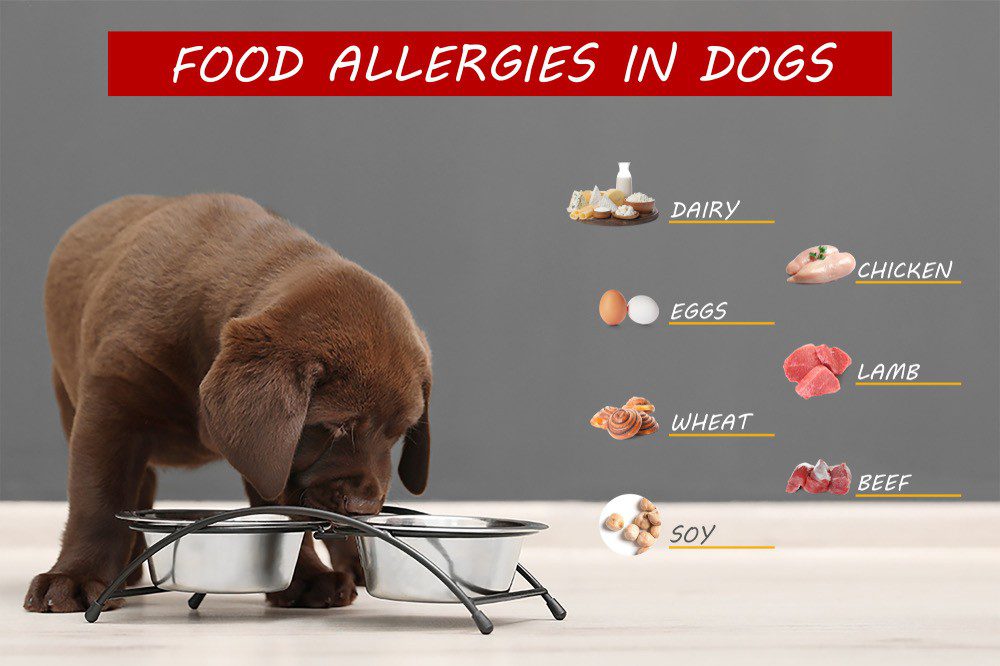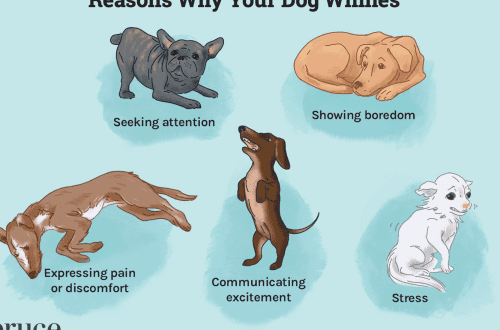
Food allergies in dogs

If the cause is indeed in the food, then the allergens are usually proteins, but they can also be preservatives and additives that are used in feed. Studies show that milk, chicken, beef, fish, as well as corn and wheat proteins provoke allergies more often than other foods. It often happens that food allergies occur in parallel with other types of allergic reactions (for example, with atopy), and this complicates the diagnosis and monitoring of the patient’s condition.
Signs of a food allergy
The symptoms of food allergies are varied, but the key symptom is persistent itchy skin that does not depend on the season and can vary in intensity. Initially, redness, pimples, specks appear on the skin, itching appears, other symptoms associated with skin injuries as a result of scratching and the addition of a secondary infection gradually join. The most commonly affected areas are the armpits, sacrum, groin, perianal region, but itching can also be generalized. The intensity of itching can vary greatly from dog to dog. Sometimes signs of a food allergy can occur in the gastrointestinal tract: for example, defecation may become more frequent, the dog will suffer from diarrhea and vomiting, or increased gas production.
One of the signs of a food allergy in dogs can be chronic or persistent otitis media (sometimes chronic otitis media can be the only symptom of this disease).
Food allergies can occur at almost any age, with the onset of symptoms often occurring before the age of one year.
Breed predisposition has not been proven, but some breeds of dogs are clearly represented more often – for example, Cocker Spaniels, Labradors, Golden Retrievers, Collies, Miniature Schnauzers, Shar-Peis, West Highland White Terriers, Dachshunds, Boxers, German Shepherds. Most likely, this is due to the fact that these breeds are predisposed to atopic dermatitis, and food allergies often occur simultaneously with atopy.
Diagnostics
To make a diagnosis and identify the cause of the allergy, it is necessary for the patient to undergo an elimination diet (an elimination diet followed by a provocation). This diagnostic method is the most accurate and most reliable. The fact is that the clinical picture of food allergies in dogs can be no different from other types of allergies and skin diseases that are accompanied by itching. For this reason, the first stage of diagnosis is always the exclusion of possible invasive diseases – in particular, demodicosis and infection with scabies mites and fleas.
For example, if a dog suffers from scabies, then the clinical manifestations of the disease will be the same as with food allergies, but no matter how the pet’s diet is adjusted, skin itching will still bother him, since the reason is not in nutrition, but in acariasis caused by scabies mite. Also, the dog will suffer from itchy skin with secondary infections and with dermatophytosis. Accordingly, before resorting to an elimination diet, you should make sure that the dog is cured of all infectious diseases or they are under control. It is equally important to regularly treat your pet for fleas, then during the diet period there will be no doubt that the body’s reaction to flea saliva can be the cause of itching.
elimination diet
The meaning of such a diet is not just to change the food, but to select a diet with new sources of protein and carbohydrates for the dog. To begin with, as a rule, a list of those products that the pet has consumed throughout his life is formed, after which something new is chosen for him. That is, if the dog has never eaten ostrich or duck meat before, this ingredient is quite suitable for a temporary diet. By the same principle, you need to choose a product that will become a source of carbohydrates. The dog should not have eaten it before in any form.
Dog diets can be prepared at home, you can also buy food with limited sources of proteins and carbohydrates, or special medicated food, which will be based on hydrolyzed proteins. The veterinarian will help with the appointment of a diet, as it is necessary to take into account the history of the dog’s life, its illnesses, conditions of detention, as well as the capabilities of the owner. It is necessary to adhere to the dietary menu and the prescribed restrictions for 8-12 weeks. If after this time progress is visible, that is, itching has significantly decreased or disappeared altogether, then it is necessary to return to the previous diet and assessment of itching. In the event that after the return itching resumed, this will be a confirmation of the diagnosis of “food allergy”.
It would seem that the simplest thing remains – to exclude allergens from the diet, and then the problem of food allergies in a dog will be solved. In reality, it turns out that everything is not so simple. Complicating the problem is that in dogs, food allergies usually coexist with other forms of allergies, making diagnosis difficult. There are other difficulties: the dog may refuse a new food specially selected for her, drag food from the table or from the bowls of other pets, even pick up something on the street. Because of this, it may be necessary to repeat the elimination diet. Therefore, it is so important that the owner, before the first diet, be ready to strictly follow all the instructions of the veterinarian, and all family members do not interfere with this process and do not feed the dog with forbidden food. For the duration of the diet, all treats, top dressings, and even vitamins and medicines, which may contain flavoring additives, should be completely excluded from the dog’s diet.
Treatment
Unfortunately, food allergies cannot be cured and completely eliminated. But, knowing the diagnosis and the source of the allergy, you can take control of its manifestation, you just need to adjust the dog’s menu by refusing certain foods.
Treatment of dogs suffering from this disease involves the selection of the optimal diet and the regulation of the intake of treats and vitamins by the animal. The owner of the pet must control the infection of the dog with secondary infections and treat it with flea remedies in a timely manner.
Unfortunately, there is no guarantee that over time a dog will not develop allergies to other foods. Then you will need to repeat the elimination diet and select a new diet. In cases where the allergy is particularly severe, the veterinarian may prescribe medication to reduce itching and discomfort in the animal.
The article is not a call to action!
For a more detailed study of the problem, we recommend contacting a specialist.
Ask the vet
14 2017 June
Updated: July 6, 2018





